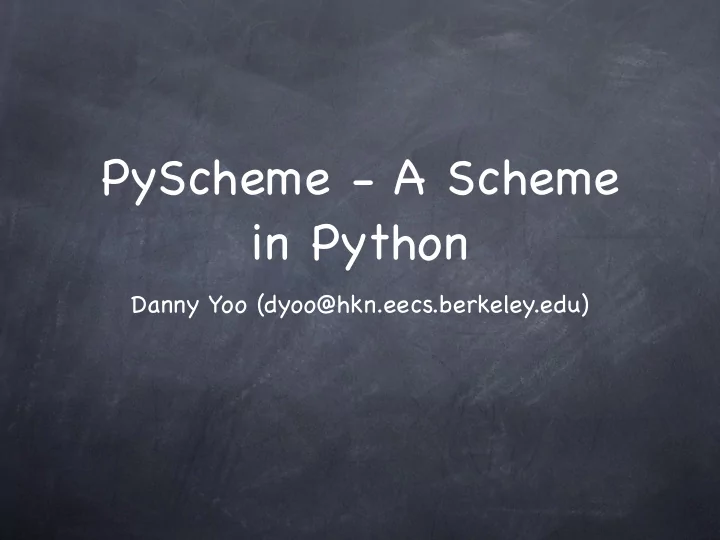

PyScheme - A Scheme in Python Danny Yoo (dyoo@hkn.eecs.berkeley.edu)
What is Scheme? (lisp-like? “scheme”) ==> #t isLikePython(”scheme”) ==> True Used in quite a few schools as the “intro” language to computer science.
What does Scheme look like? (define (say-hello) (display “Hello world!”) (newline))
Stop here for live demo (and pray to the demo godesses)
Side-by-side differences Small core syntax in Scheme. Recursion is used in places where it seems weird at first, but it works. Emphasizes expressions and their values. Easier to interpret, which leads us to the question...
How does it work? Two rules for evaluating Scheme Evaluate expressions (and subexpressions!) with eval() Apply combinations with apply()
eval() in a nutshell def evaluate(expression, environment): if expression is self-evaluating: return that expression elif expression looks like variable: look up variable in environment elif expression looks like procedure call: evaluate subexpressions, and apply procedure call on the results. [... plus a few other “special forms” to handle if/cond, and other special expressions.]
apply() in a nutshell To apply() a procedure call: 1. bind parameter names and values in a new environment namespace. 2. evaluate the body expression with that environment if the procedure is user defined. Otherwise, get Python’ s apply() to do the primitive application against the param values.
Why is this easy? Evaluation is conceptually simple: it’ s just recursion in action. [show example with instrumented interpreter] We can reuse a lot of Python’ s objects and runtime support. It’ s been done before. *grin* All of this is reinvention, so I know it’ s very doable.
Why is this hard? Recursion in Python can be ugly. >>> def factorial(x, result = 1): ... if x == 0: ... return result ... return factorial(x - 1, result*x) >>> factorial(1000) Traceback (most recent call last): File “<stdin>”, line 4, in factorial File “<stdin>”, line 4, in factorial File “<stdin>”, line 4, in factorial File “<stdin>”, line 4, in factorial File “<stdin>”, line 4, in factorial File “<stdin>”, line 4, in factorial File “<stdin>”, line 4, in factorial File “<stdin>”, line 4, in factorial File “<stdin>”, line 4, in factorial File “<stdin>”, line 4, in factorial File “<stdin>”, line 4, in factorial File “<stdin>”, line 4, in factorial File “<stdin>”, line 4, in factorial File “<stdin>”, line 4, in factorial RuntimeError: maximum File “<stdin>”, line 4, in factorial File “<stdin>”, line 4, in factorial File “<stdin>”, line 4, in factorial File “<stdin>”, line 4, in factorial recursion depth exceeded File “<stdin>”, line 4, in factorial File “<stdin>”, line 4, in factorial .... ....
Ok, how do we get around this? Well...
We’ve actually seen trampolines before! import Tkinter root = Tk() def sayHi(): def sayHi(): print “hi” print “hi!” root.after(10, sayHi) sayHi() sayHi() root.mainloop()
Boing, boing. def pogo(bouncer): while callable(bouncer): bouncer = bouncer() return bouncer def bounce(f, *args): return lambda: f(*args) Demo time again!
One problem with trampolines... def factorial(n): if n == 0: return 1 return n * factorial(n-1) Where do we bounce? Trampolines don’t work unless the function has a certain shape. Technically, trampolines work only if all the nontrivial function calls are “tail” calls.
Rescued by... Continuation Passing Form? def identity(x): return x def factorial(n): if n == 0: def c_factorial(n, k = identity): return 1 if n == 0: return n * factorial(n-1) return k(1) else: def c(result): return k(n * result) return c_factorial(n-1, c)
So...? A CPS’ed program can be trampolined in a fairly mechanical (mindless) way. So I CPSed the entire interpreter by hand. Isn’t this ugly? Yes. Oh well.
Why in the world would you do this? It’ s a great way to learn Python as well as Scheme. There’ s a saying that programmers learned more about Lisp by learning Python. I’m sorta going the other direction: learning Python by implementing Lisp. I’m fascinated by programming languages.
References and good reading http:/ /hkn.eecs.berkeley.edu/~dyoo/python/ pyscheme SICP: Structure and Interpretation of Computer Programs Essential of Programming Languages Programming Languages - Application and Interpretation SICP and PLAI are both online!
Recommend
More recommend